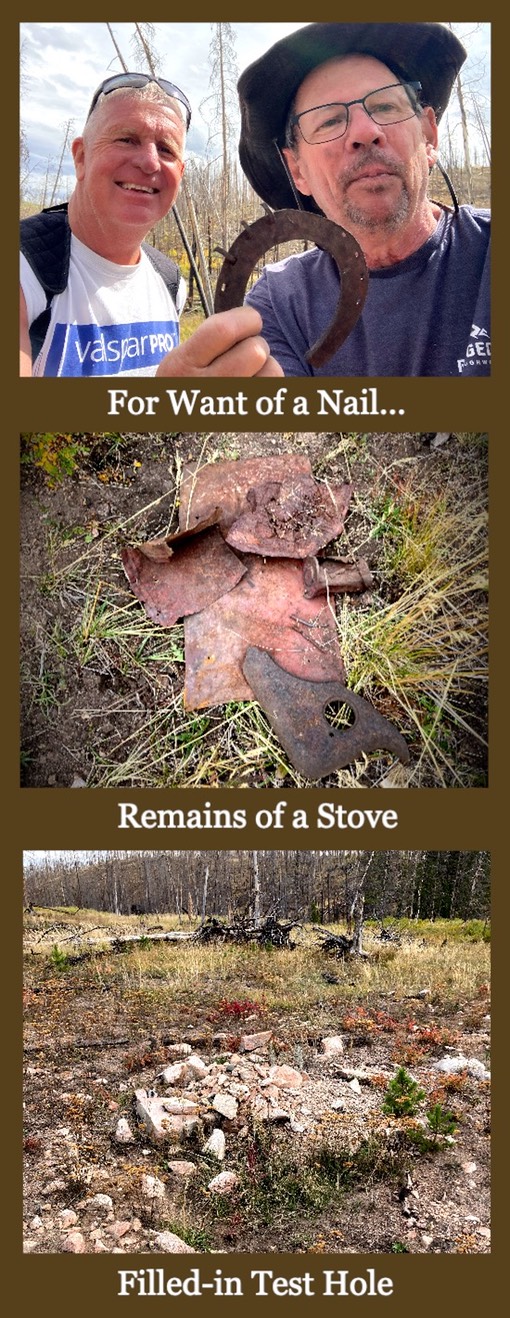In her 1979 book The Lovewell Family Gloria Lovewell shares an amusing family tale about one of Thomas Lovewell’s last prospecting adventures in Wyoming. Thomas and two companions had rigged up a windlass to help them haul buckets of earth from the bottom of a deep test hole, and they were sifting through the contents when the elderly Thomas let out a whoop and began to dance a jig.
Nestled among the clods of dirt and assorted pebbles, the dull sheen of a golden nugget had caught his eye. After so many years of fruitless searching, the mother lode just might be within reach. One of the helpers realized he would have to break the news to the old prospector that the nugget was a souvenir which had fallen off someone’s tie clip as he leaned over the test hole.
After repeating the story in her recent compendium The Lovewell Family Revisited, Thomas’s granddaughter Rhoda Lovewell couldn’t help adding the remark, “Who digs for gold with a tie and tie clip on?” Sensible quibbles aside, Thomas Lovewell really did lead a rellentless search for El Dorado in the autumn of his life, and thanks to the availability of newspaper archives we can piece together a broad outline of his activities. Fortunately, one intrepid researcher has taken his research a step further.
Phil Thornton stands where a cabin once marked the headquarters of the Josephine Lode (The remains of a stove are visible at the bottom of the photo)

Thomas Lovewell sailed to Alaska to size up prospects at Nome and York in 1900, before starting rounds of yearly visits (usually by wagon) from Lovewell, Kansas, to the wilderness west of Laramie. It was a tradition which he doggedly maintained through at least 1908. Thus, the old pioneer plugged away at his quest for about as long as his great-great-grandson Phil Thornton has spent looking for physical evidence of Lovewell’s presence in Wyoming. As of 2025 Phil finally has the receipts.
From accounts of the thrilling family excursion in 1903, which Thomas’s ailing daughter Josephine and her children only survived by rushing out of their cabin before an accidental explosion shook the rafters, Phil knew the exact dimensions of the cabin he was looking for, even though the timbers were surely long-gone.
After nearly a decade of searching, Phil, along with his buddy Dane Freshour, hit paydirt - literally. What they found was dirt in the form of an earthen berm which had once outlined a cabin of exactly the right size. The berm itself had been created by piling soil against the base of the exterior walls. Also surviving were the remnants of an old stove and stovepipe, and some broken bottles. In the same vicinity were test holes that had been filled in and covered with stones, and at a nearby site, a solitary horseshoe.
All of these discoveries were made in the vicinity of Squirrel Creek, which had a diversion for sluicing, with two nearby springs supplying fresh drinking water. It made a perfect setting for an annual summer getaway even if it never proved a rewarding site for unearthing fabulous riches.
Phil made no mention of coming upon a solitary golden nugget, possibly tossed away in apparent frustration before abandoning the site. No matter - I’m not quite sure I bought that part of the story anyway.
For the unadulterated truth about Thomas Lovewell's visit to Alaska see “Locked In an Iceberg"
For more on Lovewell in Wyoming see “You Know That Wyoming Will Be Your New Home” as well as “Tracing the Golden Trails"
For an account of the great dynamite fiasco of 1903 see “A Bang-Up Time
Fancifal names for Wyoming mining claims are at “The Bible, the Beatles, & the Board of Trade"
To follow some of Phil’s earlier searches in Wyoming see “Reclaiming History"